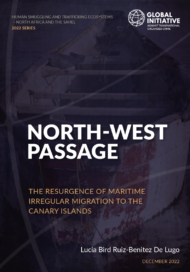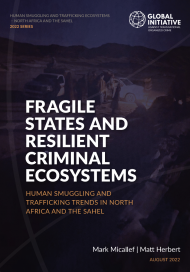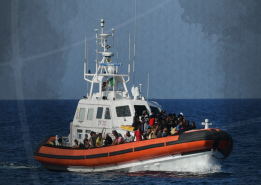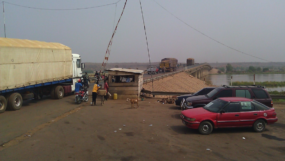Over the last two years, the level of irregular migration from West and North Africa to Spain’s Canary Islands has surged. Between January 2020 and late October 2022, 60 427 migrants disembarked in the Canary Islands, compared to 9 520 between January 2009 and December 2019.
An unknown, but probably significant, number of migrants attempting the journey have been intercepted over the period by Moroccan, Mauritanian or Senegalese authorities, or have disappeared at sea. Available statistics for disappearances at sea demonstrate the north-west African route (also known as the Canary Islands or Atlantic route) is one of the deadliest in the world. The situation is worsening – in 2021, estimated numbers of deaths at sea on the route were double those of the previous year.
The increased use of the route is particularly striking when compared with the three other major migration routes from North Africa to Europe: the central Mediterranean route (linking Libya, Tunisia and Algeria with Italy), the western Mediterranean route (linking Morocco and Algeria with the Spanish mainland, its Mediterranean Islands and its North African enclaves) and the eastern Mediterranean route (linking Turkey with Greece). Between January 2020 and late 2022, the north-west African route grew from a zone of minimal movement to one of the busiest irregular migration routes to Europe.
The spike in the popularity of the north-west African route is not unprecedented – it echoes the 2006 surge in movement across this route, where arrivals to the Canaries exceeded 30 000, before falling sharply once more. The reasons for the recent rising popularity of the route vary, based on migrant nationalities and departure locations. However, the key driver cited by many migrants travelling on this route is the search for economic opportunity against a backdrop of declining livelihoods at home, while barriers to licit travel to Europe necessitate accessing irregular methods of movement. In turn, choices of clandestine routes hinge on accessibility, affordability, surety of arrival and safety.
COVID-19 has had an impact on all of the above, though a rise in the level of migration along the route slightly pre-dates the advent of the pandemic in North and West Africa. Efforts by governments in these countries to combat the pandemic has impacted livelihoods, altering the feasibility of mobility – particularly through air and land routes – and increasing the demand for the Canary Islands route substantially. This is particularly the case in Morocco, as migration routes across the Mediterranean become more difficult to access due to heightened surveillance and movement restrictions linked to COVID-19, as explored further below. The situation compounded the already growing difficulties of using alternative irregular routes into Europe, which have become harder and more dangerous as Europe has sought to block them.
Since the north-west African route’s resurgence in 2020, most irregular migrants and refugees have been Moroccan, departing from points in southern Morocco or Western Sahara. Large numbers of West Africans have also moved along the route, some leaving from Morocco or Moroccan-administered Western Sahara, while others embarked from beaches in Senegal or Mauritania.
This report investigates the dynamics underpinning the current use of the north-west African migration route. The first section looks at the historical context of how this route emerged, with a focus on a previous surge in migration along it in between 2005 and 2006. The following section examines current trends, embarkation zones and the operations of smuggling networks facilitating movement on this route. A brief assessment is made of economic and political drivers of irregular migration, followed by a discussion of Spanish government responses. The report ends with a conclusion and a set of recommendations.
Passage du nord-ouest : Recrudescende des migrations irrégulières par voie maritime vers les Îles Canaries
Ces deux dernières années, les migrations irrégulières en provenance d’Afrique du Nord et de l’Ouest vers les îles Canaries (Espagne) ont connu un essor considérable. Entre janvier 2020 et fin octobre 2022, 60 427 migrants ont débarqué aux îles Canaries, contre 9 520 entre janvier 2009 et décembre 2019. Au cours de cette même période, un nombre inconnu, mais probablement significatif, de candidats à la traversée ont été interceptés par les autorités marocaines, mauritaniennes ou sénégalaises, ou ont disparu en mer. Les statistiques disponibles relatives aux disparitions en mer montrent que la route de l’Afrique du Nord-Ouest (également connue sous le nom de route des Canaries ou route de l’Atlantique) est l’une des plus meurtrières au monde. En 2021, le nombre estimé de personnes mortes en mer sur cet itinéraire a doublé par rapport à l’année précédente.
L’augmentation, en 2020 et 2021 notamment, des flux migratoires le long de cette route est particulièrement frappante si on la compare à la croissance moins forte enregistrée au cours de cette période de deux ans sur les trois autres grandes routes migratoires de l’Afrique du Nord vers l’Europe : la route de la Méditerranée centrale (qui relie la Libye, la Tunisie et l’Algérie à l’Italie), la route de la Méditerranée occidentale (qui relie le Maroc et l’Algérie au continent espagnol, à ses îles méditerranéennes et à ses enclaves nord-africaines) et la route de la Méditerranée orientale (qui relie la Turquie à la Grèce). Très peu utilisée auparavant, la route de l’Afrique du Nord-Ouest est devenue la route la plus fréquemment empruntée par les migrants clandestins pour gagner l’Europe entre janvier 2020 et fin 2022. Bien que les mouvements sur cette route aient diminué au cours de l’année 2022, ils sont restés sensiblement plus élevés qu’avant 2020.
Ce n’est pas la première fois que cette route connaît un pic de popularité. En 2006, plus de 30 000 arrivées avaient en effet été dénombrées aux îles Canaries, ce chiffre ayant ensuite brusquement chuté. Les raisons de la popularité croissante de cet itinéraire varient selon la nationalité des migrants et leur lieu de départ. Le principal facteur déterminant cité par un grand nombre des migrants empruntant cette route reste cependant la recherche d’un emploi dans un contexte de déclin des moyens de subsistance dans leur pays, les obstacles aux voyages licites vers l’Europe les obligeant à recourir à des modes de déplacements illégaux. Le choix des itinéraires clandestins dépend quant à lui de l’accessibilité, du coût, de la garantie d’arrivée et de la sécurité de ceux-ci.
La COVID-19 a eu un impact sur tous ces éléments même si l’augmentation des flux migratoires le long de la route étudiée est légèrement antérieure à l’apparition de la pandémie en Afrique du Nord et de l’Ouest. Les efforts déployés par les gouvernements des pays concernés pour lutter contre la pandémie ont eu une incidence sur les moyens de subsistance de la population, modifiant les possibilités de déplacement, notamment par voies aériennes et terrestres, et augmentant sensiblement la demande de transit par la route canarienne. Le Maroc a été particulièrement touché, les routes migratoires à travers la Méditerranée devenant plus difficiles d’accès en raison d’une surveillance accrue et des restrictions de mouvement liées à la COVID-19, comme nous le verrons plus loin. Ces facteurs sont venus aggraver les difficultés de plus en plus nombreuses pour emprunter d’autres voies d’accès irrégulières à l’Europe, devenues plus ardues et plus dangereuses à mesure que l’Europe s’employait à les bloquer.
La plupart des migrants irréguliers et des réfugiés qui empruntent de manière croissante la route de l’Afrique du Nord-Ouest depuis 2020 sont marocains et partent du sud du Maroc ou du Sahara occidental. Un grand nombre d’Africains de l’Ouest ont également recouru à cet itinéraire, certains partant du Maroc ou du Sahara occidental sous administration du Maroc, d’autres embarquant depuis des plages sénégalaises ou mauritaniennes.
Le présent rapport étudie les dynamiques qui sous-tendent l’utilisation actuelle de la route migratoire de l’Afrique du Nord-Ouest. Dans une première partie, nous examinerons le contexte historique dans lequel cette route s’est créée en mettant l’accent sur la vague de migrations qui l’a suivie entre 2005 et 2006. Dans la partie suivante, nous nous intéresserons aux tendances actuelles, aux lieux d’embarquement et aux opérations des réseaux de passeurs qui facilitent les déplacements sur cet itinéraire. Nous passerons rapidement en revue les facteurs économiques et politiques qui favorisent les migrations irrégulières puis traiterons des réponses du gouvernement espagnol. Le rapport se terminera sur une conclusion et une série de recommandations.





